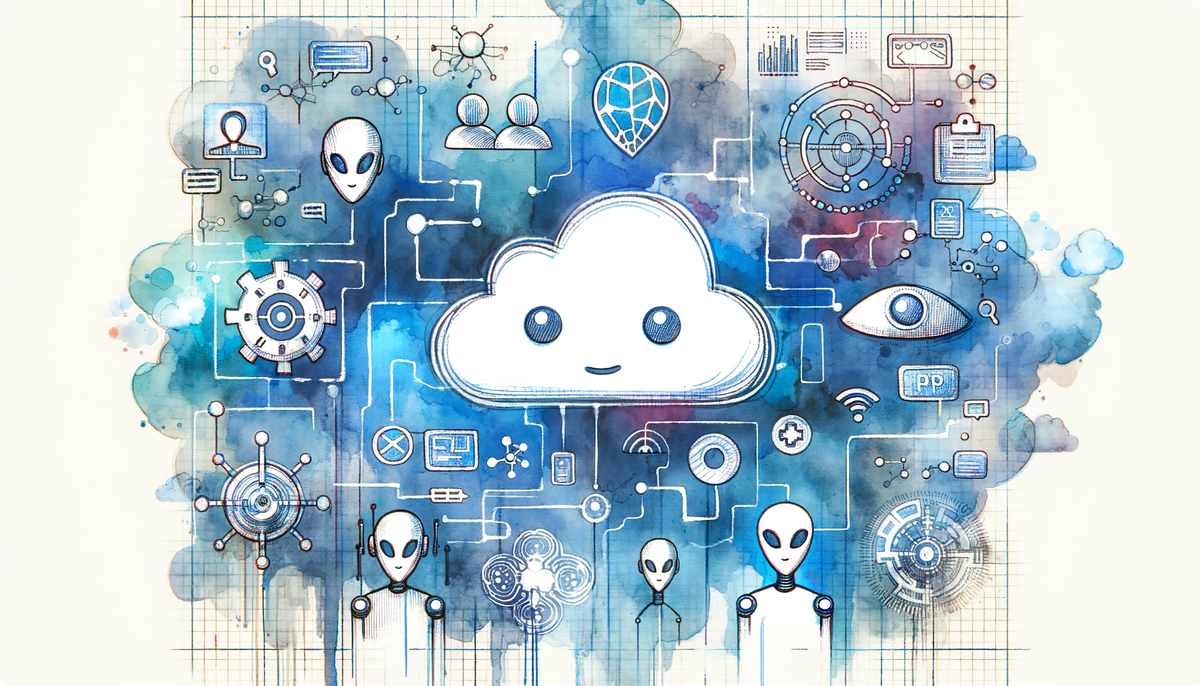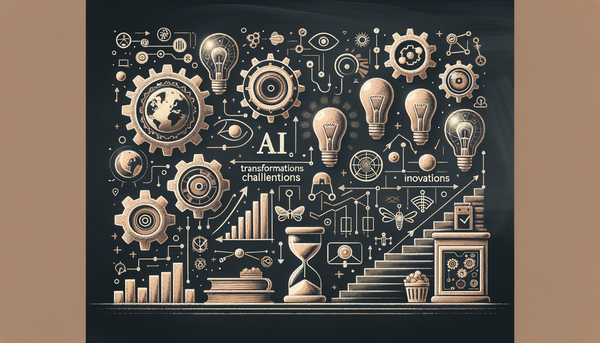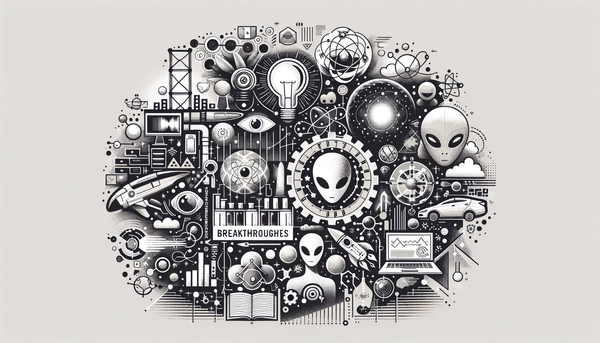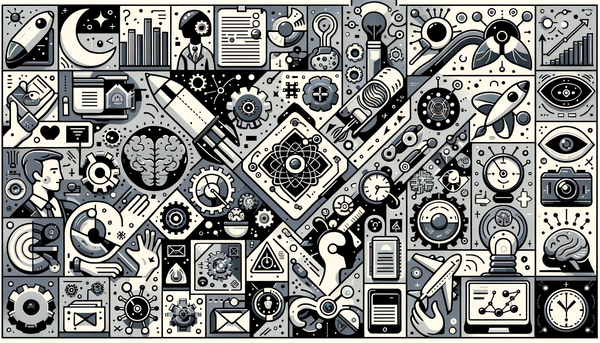Exploring the Latest in AI: GPT-4.5, Labor Theory, and Innovations

One year after unveiling its groundbreaking voice cloning technology, OpenAI’s Voice Engine remains in preview mode, its silence speaking volumes about the strides—and concerns—in cutting‐edge AI. At the same time, transformative developments from Qualcomm’s agentic AI to Crogl’s “Iron Man suit” for cybersecurity, alongside thought-provoking discussions on AI’s role in labor control, the nuanced performance of GPT-4.5, Shazam’s evolving music integration, and unsettling deepfake phishing incidents on YouTube, together paint a vivid portrait of an industry in deep transition.
Voice Cloning in Limbo: The Case of OpenAI’s Voice Engine
A year has gone by since OpenAI first showcased its much-hyped voice cloning tool, Voice Engine, a system claiming to replicate a person’s voice using just a 15-second sample of audio. Despite an impressive early demonstration, the technology is still stuck in a “small-scale preview,” with a public launch date remaining elusive. The hesitance to roll out this innovation broadly points to a careful balancing act between rapid technological advancement and ensuring robust safety measures.
OpenAI appears to be meticulously refining safety layers—demanding user consent before synthesizing any voice and embedding watermarking systems to trace audio origins. This cautious approach is hardly surprising in an era when voice cloning has been linked to high-profile scams and deepfake scenarios. For instance, some early adopters like Livox, a startup focused on communication aids for people with disabilities, have lauded the tool’s natural-sounding output while also noting the absence of an offline version which might be crucial for privacy and accessibility.
"By far the greatest danger of Artificial Intelligence is that people conclude too early that they understand it." – Eliezer Yudkowsky, Artificial Intelligence as a Positive and Negative Factor in Global Risk
The decision to keep Voice Engine under wraps until it meets safety benchmarks has sparked a lively debate in tech circles. Many wonder if the delay is a sign of potential misuse under regulatory pressures or simply OpenAI’s internal prioritization of ethical considerations. The discussion is reminiscent of concerns raised in other detailed analyses on responsible AI releases, as explored in Open AI's Stand Against Misuse and the Future of AI in Everyday Life.
Further insights on this topic can be found in the TechCrunch article on Voice Engine, which outlines the multifaceted challenges facing voice cloning technology—ethical, practical, and regulatory.
Redefining Interaction: The Rise of Agentic AI and the End of Apps?
In a striking departure from traditional interfaces, Qualcomm recently introduced a visionary concept known as "agentic AI" at Mobile World Congress 2025. Far from simply updating software, these intelligent agents have the potential to redefine our digital interactions by replacing conventional apps with holistic, voice-activated personal assistants. Imagine an AI that not only manages your schedule and handles everyday tasks but also takes the initiative to secure movie tickets or manage your commute seamlessly.
Qualcomm’s vision, articulated passionately by Durga Malladi, is as revolutionary as it is unsettling. The prospect of an AI that mirrors our daily habits brings with it both excitement and a measure of trepidation. On one hand, the idea of erasing the clutter of multiple apps in favor of a single, intuitive agent promises an unprecedented level of convenience. On the other, privacy concerns loom large. As these digital companions become more integrated into our lives, they will inevitably require deep access to personal data, potentially blurring the line between helpfulness and intrusion.
This evolution in user interface design may seem straight out of a futuristic novel or even a Black Mirror episode, but it’s grounded in current innovations. Critics point out that many specialized tools rely on visual feedback—something that might be lost when transitioning fully to AI-driven interactions. Moreover, this move raises questions about the sustainability of free software models that traditionally depend on in-app advertising revenue. The debate on whether apps will become relics of a bygone era is shaping a critical dialogue in tech forums today.
For readers curious about broader AI impacts, exploring the narrative in our piece on Exploring the Multifaceted World of AI may offer further perspectives on how digital transformation is evolving.
More detailed consideration of Qualcomm’s bold predictions is available in this TechRadar analysis.
High-Tech Armor: Crogl’s AI ‘Iron Man Suit’ for Cybersecurity
As digital threats increase in complexity and frequency, the cybersecurity realm is turning to innovative AI solutions to augment human capabilities. One such breakthrough comes from Crogl, a startup bolstered by a significant $30 million investment, which recently unveiled an AI-powered assistant specifically designed for security analysts. Dubbed as an “Iron Man suit” for cybersecurity, this tool is engineered to sift through the deluge of alerts analysts face daily, filtering out noise and highlighting critical threats.
Crogl’s innovation hinges on its “knowledge engine,” a system that learns from each alert and adapts its monitoring capabilities accordingly. By integrating machine learning algorithms into everyday threat analysis, the platform empowers security teams to take decisive, informed actions in real time. The analogy to Batman’s utility belt—or even Iron Man's suit—aptly captures the tool’s promise: a seamless blend of human intuition and machine precision.
Monzy Merza, CEO of Crogl, cites deep industry challenges experienced during his tenure at renowned organizations like Sandia National Laboratories and Splunk. His experiences fuel the vision behind the new tool, which seeks not only to advise but also to actively assist in the remediation of threats.
This amalgamation of automation and human expertise highlights how AI can be harnessed not just as a standalone solution, but as a multiplier of human potential in high-stakes environments. For further technical insights and real-world applications of such technologies, consider reading our feature on Latest Developments in AI Innovations.
More details on Crogl’s pioneering tool are discussed in the TechCrunch release.
AI and Labor: Revisiting the Historical Roots of Automation
The transformation of work through AI extends well beyond new gadgets and apps—it touches on the very structure of labor and management. Matteo Pasquinelli’s provocative treatise, as reviewed in The Labor Theory of AI, weaves modern AI developments into the historical tapestry of labor control and automation. This perspective is a powerful reminder that innovation often rides on the back of centuries-old ideas about management and productivity.
Pasquinelli draws parallels between the mechanization of mental tasks envisioned by visionaries like Charles Babbage and today’s sophisticated AI systems. In his narrative, AI functions as the digital “eye of the master”—seeing every element of the workforce, orchestrating tasks, and subtly guiding behavior towards ever greater efficiency. This observation offers a sobering look at how far we’ve come, and raises provocative questions about control, creativity, and the future of human work.
The discussion extends to ethical and legal quandaries surrounding copyright infringement, as AI systems are increasingly trained on vast datasets of creative work without explicit consent. It is in this space that the tension between collective creative achievement and individual ownership becomes most palpable. While the intellectual democratization of knowledge through AI is undeniably progressive, it forces us to reconsider the boundaries of innovation and intellectual property.
Engaging with these layers of thought, one might recall a wise sentiment: "Technology could benefit or hurt people, so the usage of tech is the responsibility of humanity as a whole, not just the discoverer. I am a person before I'm an AI technologist," a reminder from Fei-Fei Li that power must be tempered by responsibility.
GPT-4.5: A Balancing Act Between Human Nuance and Technical Performance
OpenAI’s rollout of GPT-4.5 marks another significant step in the ongoing quest for more human-like AI, though it has met with mixed reviews. Positioned as an ambitious yet still research-centric evolution of its predecessors, GPT-4.5 delivers modest improvements in emotional nuance and conversational fluidity. Early adopters have noted its ability to generate more compelling headlines and seemingly understand user intent better—yet, when it comes to in-depth research or complex reasoning tasks, the model sometimes falls short.
The rollout of GPT-4.5 also illustrates the perennial challenge of balancing innovation with practicality. While the enhancements make interactions feel less robotic, some critics argue that the changes represent mere incremental upgrades rather than the breakthrough leap toward Artificial General Intelligence (AGI) that many enthusiasts had hoped for. As OpenAI edges closer to its ambitious GPT-5, questions remain about whether these AI improvements are delivering practical benefits or simply acting as a high-profile academic exercise.
Pricing strategies, such as the introduction of a credit-based subscription model for premium access, have also sparked debate about accessibility and equity in the AI ecosystem. Though the premium service is aimed at those who seek refined conversational experiences, it may leave behind a segment of users who are accustomed to more open-access models.
For those interested in a first-hand look at GPT-4.5, the Wired review offers a detailed exploration of its strengths and areas for improvement.
Harmonizing Technology and Lifestyle: Shazam’s Playlist Integration
It isn’t just groundbreaking AI tools for heavy industries capturing headlines—consumer tech is also embracing AI in intriguing ways. Shazam, long celebrated as a household name for music recognition, has updated its platform to integrate seamlessly with popular streaming services like Spotify and Apple Music. Now, every time you identify a catchy tune, it can automatically be added to your “My Shazam Tracks” playlist, providing an effortless bridge between discovery and enjoyment.
This innovation simplifies the user experience by eliminating the need to manually save or search for songs, reflecting a broader trend of embedding AI into our everyday routines. Whether you’re exploring new music on the go, rediscovering forgotten favorites, or curating the perfect playlist for a long drive, Shazam’s update is poised to enrich daily life in subtle yet significant ways.
Beyond its core functionality, Shazam’s integration hints at a future where digital experiences are increasingly personalized and interconnected. The feature extends to songs identified through diverse channels—be it via Siri, Shortcuts, or the Control Center—underscoring how AI is quietly transforming our interaction with media. For further guidance on leveraging AI to enhance everyday tasks, our article on A Suite Of Job Readiness Skills For Graduates Working With AI provides useful insights.
More technical details and a step-by-step overview of the update can be found in this TechRadar piece on Shazam’s latest update.
Cybersecurity in the Age of Deepfakes: YouTube’s Warning on Phishing Videos
In a cautionary tale underscoring the dual nature of AI, YouTube has recently confronted a sophisticated phishing scam that exploits a deepfake of its CEO, Neal Mohan. Cybercriminals are using this AI-generated impersonation to send out private video messages alleging urgent changes to monetization policies—designed to trick users into surrendering personal credentials.
The phishing videos, which mimic legitimate communications, lure victims into clicking dubious links under the guise of account updates. This nefarious use of AI technology not only jeopardizes individual user security but also undermines trust in digital communications, reminding us that while AI can empower and innovate, it can equally be weaponized for deception.
YouTube strongly advises its community to be wary of any private video notices claiming to originate from the platform. For anyone wanting to understand more about safeguarding personal information in the digital era, it is important to stay informed about these emerging threats. The details of this phishing scheme are elaborated upon in a TechRadar report, which serves as both a warning and a guide to better digital hygiene.
Synthesizing the AI Narrative: Implications Across Industries
The myriad developments discussed—from delayed voice cloning and revolutionary AI agents to enhanced cybersecurity measures and the subtle evolution of chatbots—collectively reveal an industry that is as transformative as it is cautious. Experimental tools are emerging at a dizzying pace, while established tech giants grapple with ethical challenges and security concerns. In sectors spanning from communication and entertainment to cybersecurity and labor, AI is redefining traditional paradigms and rewriting the rules of engagement.
This confluence of innovation and deliberation is a vivid reminder that the deployment of AI technologies is not a linear path toward progress but a complex, iterative journey. Some advancements inspire optimism—empowering individuals with tools akin to an "Iron Man suit"—while others caution us to tread carefully, as seen in the case of voice cloning delays and deepfake scams.
Whether you’re a developer, a policy maker, or simply a curious observer of technological trends, it’s worth noting that the narrative of artificial intelligence is still being written. Each breakthrough carries with it the promise of enhanced capabilities as well as the responsibility to manage its impact safely and ethically. For further reflection on these multifaceted developments, our ongoing coverage in Exploring the Multifaceted World of AI provides excellent context and continuous updates.
As Satya Nadella once remarked, "We are entering a new phase of artificial intelligence where machines can think for themselves." This evolving landscape invites us all to ponder the balance between unfettered innovation and the safeguarding of our societal values.
Looking Forward: The Future of AI Integration
While the current suite of innovations offers a snapshot of the rapid pace of change, the future of artificial intelligence remains both thrilling and uncertain. As companies like OpenAI, Qualcomm, and Crogl push the boundaries of what machines can do, society is faced with the task of integrating these technologies in ways that maximize benefit while minimizing risk.
The journey ahead is likely to involve intricate negotiations between technological ambition and ethical restraint. The current mix of innovations—from experimental frameworks and sophisticated user interfaces to proactive security measures—is setting the stage for more ubiquitous, integrated, and intelligent systems. Yet, each new tool, no matter how awe-inspiring, comes with the inherent responsibility of ensuring that it does not compromise privacy, security, or the essence of human creativity.
In the end, AI’s trajectory is as much about human ingenuity as it is about algorithmic prowess. It calls for a concerted effort by technology developers, regulators, and users alike to harness innovation responsibly. Maybe, through thoughtful dialogue and a commitment to ethical practice, the industry can truly live up to its promise of bettering the human condition.
For readers eager to delve deeper into where technology intersects with everyday life, revisit our perspectives on groundbreaking shifts in AI and job skills in our piece on Navigating the Impact of AI on Job Skills, Innovations and Ethical Challenges.




